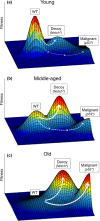Decoy fitness peaks, tumor suppression, and aging
- PMID: 30848555
- PMCID: PMC6516171
- DOI: 10.1111/acel.12938
Decoy fitness peaks, tumor suppression, and aging
Abstract
Recent reports by Martincorena et al and Yokoyama et al reveal unanticipated dynamics of somatic evolution in the esophageal epithelium, with clonal expansions apparently driven by mutations in Notch1 dominating the epithelium even in middle-aged individuals, far outpacing the prevalence of these mutations in esophageal cancers. We propose a model whereby the promotion of clonal expansions by mutations such as in Notch1 can limit more malignant somatic evolutionary trajectories until old ages.
© 2019 The Authors. Aging Cell published by the Anatomical Society and John Wiley & Sons Ltd.
Conflict of interest statement
None declared.
Figures

Comment on
-
Somatic mutant clones colonize the human esophagus with age.Science. 2018 Nov 23;362(6417):911-917. doi: 10.1126/science.aau3879. Epub 2018 Oct 18. Science. 2018. PMID: 30337457 Free PMC article.
-
Age-related remodelling of oesophageal epithelia by mutated cancer drivers.Nature. 2019 Jan;565(7739):312-317. doi: 10.1038/s41586-018-0811-x. Epub 2019 Jan 2. Nature. 2019. PMID: 30602793
References
Publication types
MeSH terms
Grants and funding
LinkOut - more resources
Full Text Sources

